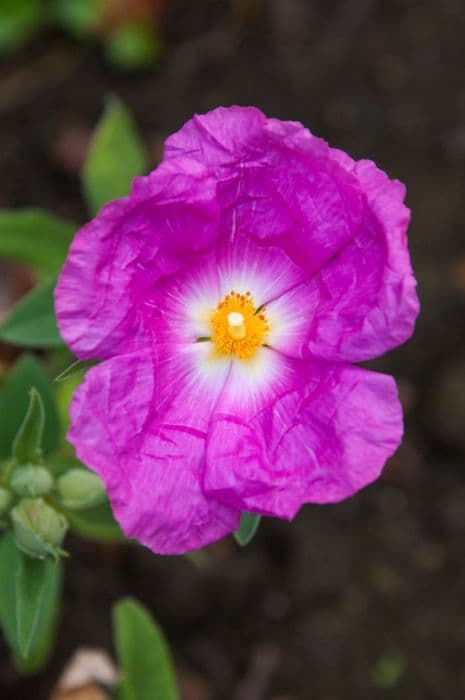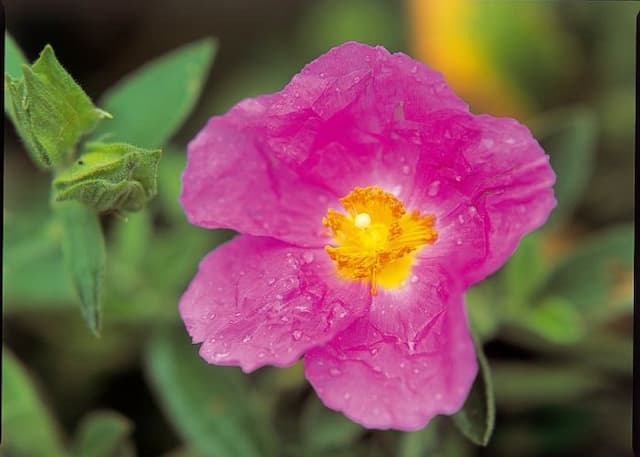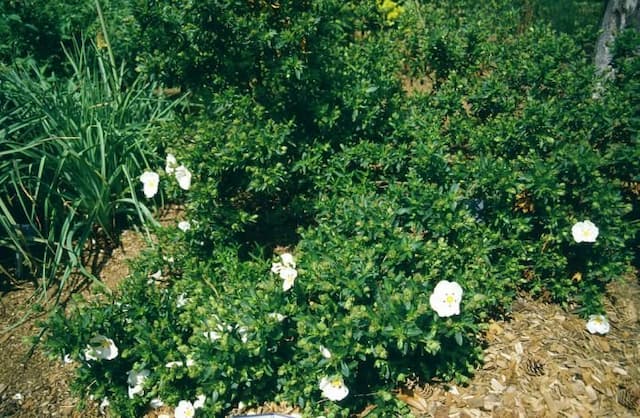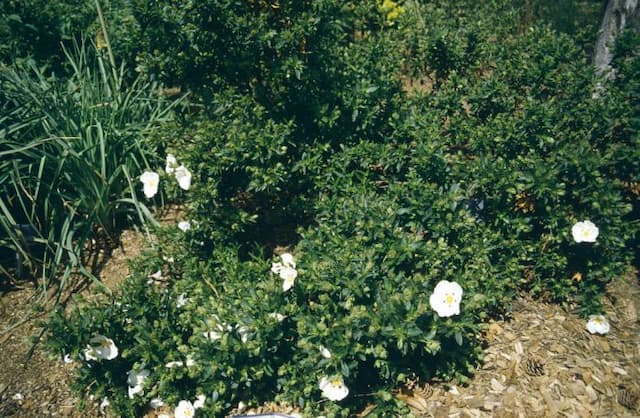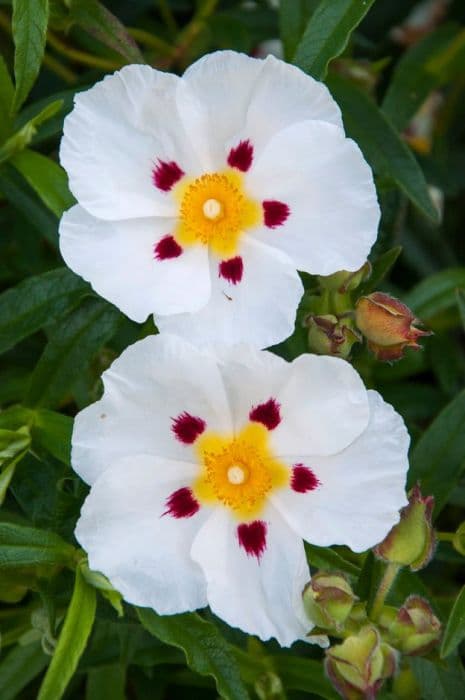Grayswood Pink Rockrose Cistus × lenis 'Grayswood Pink'

ABOUT
Cistus × lenis 'Grayswood Pink', commonly known as rockrose, boasts delicate pink blooms that exude an effortless charm. Each of these flowers comprises five rounded petals, arranged in a classic, open-faced pattern that is reminiscent of single roses. The petals are tissue-paper-like in texture, giving them a soft, ephemeral quality. At the center of each blossom is a cluster of prominent, golden-yellow stamens that stand in beautiful contrast against the pale pink petals. The foliage of the rockrose is equally attractive. The leaves are a deep green hue, with a slightly sticky and leathery feel to them, often releasing a pleasant, resinous scent when brushed against or warmed by the sun. The leaves' edges can be slightly wavy, adding texture to the overall appearance of the plant. The rockrose forms a rounded, bushy shrub, with a dense habit that makes it ideal for adding structure to garden compositions. Its overall impression is one of casual elegance, with the loose array of flowers creating a carefree and inviting display. This plant is highly valued for its drought tolerance and resilience, making it a popular choice for gardeners who are seeking a balance between ornamental appeal and low-maintenance requirements.
About this plant
 Names
NamesSynonyms
Grayswood Pink Rockrose, Grayswood Pink Cistus
Common names
Cistus × lenis 'Grayswood Pink'.
 Toxicity
ToxicityTo humans
Rockrose (Cistus × lenis 'Grayswood Pink') is generally considered non-toxic to humans. There are no common reports of poisoning or adverse reactions in humans from ingesting or handling this plant.
To pets
Rockrose (Cistus × lenis 'Grayswood Pink') is not commonly known to be toxic to pets either. It is not listed among plants that are poisonous to dogs, cats, or other animals, and there should be no symptoms of poisoning in pets from ingesting parts of this plant.
 Characteristics
CharacteristicsLife cycle
Perennials
Foliage type
Evergreen
Color of leaves
Green
Flower color
Pink
Height
3 feet [0.91 meters]
Spread
5 feet [1.52 meters]
Plant type
Shrub
Hardiness zones
8
Native area
Mediterranean
Benefits
 General Benefits
General Benefits- Drought Tolerance: Adaptable to dry conditions once established, reducing the need for frequent watering.
- Low Maintenance: Requires minimal pruning and care, making it ideal for gardeners seeking hassle-free plants.
- Attracts Pollinators: Flowers attract bees and butterflies, supporting local ecosystems and biodiversity.
- Decorative Flowers: Produces pink flowers that add color and visual interest to garden spaces.
- Rapid Growth: Typically grows quickly, providing fast coverage or filling in garden spaces.
- Deer Resistance: Generally not favored by deer, which can help protect the plant in areas where deer grazing is a problem.
- Erosion Control: The plant's root system can help stabilize soil and control erosion on slopes.
- Evergreen Foliage: Maintains leaves throughout the year, providing persistent greenery and structure in the garden.
- Adaptable to Poor Soils: Capable of thriving in less fertile soils, making it suitable for challenging planting sites.
- Suitable for Coastal Areas: Tolerant of sea spray and saline conditions, ideal for coastal landscaping.
- Hardy Nature: Withstands cold temperatures, making it suitable for a range of climate zones.
 Medical Properties
Medical PropertiesThis plant is not used for medical purposes.
 Air-purifying Qualities
Air-purifying QualitiesThis plant is not specifically known for air purifying qualities.
 Other Uses
Other Uses- Cistus 'Grayswood Pink' can be used as a natural insect repellent due to its sticky resin which many insects find unappealing.
- The plant's resin, known as labdanum, is traditionally used in perfumery for its warm, amber-like fragrance.
- Create a habitat for beneficial insects; its dense foliage offers shelter for predator insects that control garden pests.
- Used in dye production, the plant can provide a range of colors from its leaves and flowers for natural fabric dyes.
- Cistus 'Grayswood Pink' can be planted to combat soil erosion because of its extensive root system that holds soil together.
- The resin from Cistus 'Grayswood Pink' may be utilized in crafting eco-friendly soaps and candles with a pleasant fragrance.
- In artistic activities, the plant's unique form and flowers can be used in photography and botanical illustration as a subject.
- Use the dried flowers for potpourri; they maintain a subtle fragrance and add a nice visual touch to dried arrangements.
- Employ as a calming agent; while not for ingestion, the scent of the plant can have a soothing effect in gardens and sitting areas.
- For culinary presentation, fresh flowers of Cistus 'Grayswood Pink' can be used to garnish and beautify dishes.
Interesting Facts
 Feng Shui
Feng ShuiThe Rockrose is not used in Feng Shui practice.
 Zodiac Sign Compitability
Zodiac Sign CompitabilityThe Rockrose is not used in astrology practice.
 Plant Symbolism
Plant Symbolism- Beauty: With its delicate pink flowers, 'Grayswood Pink' is often associated with beauty and grace.
- Survival: Cistus, commonly known as Rockrose, often grows in poor soil and tough conditions, symbolizing the ability to thrive in adversity.
- Resilience: Rockrose is known for its hardy nature, representing resilience and the capacity to recover from challenges.
- Healing: Some species of Cistus are used in traditional medicine, so 'Grayswood Pink' can symbolize healing and restoration.
- Purity: The clear, bright color of the flowers may convey purity and innocence.
 Water
WaterThe Rockrose 'Grayswood Pink' should be watered regularly, but care must be taken not to overwater as it prefers drier conditions once established. During the first growing season, water the plant deeply once a week, allowing for about 1 to 1.5 gallons of water, to encourage a strong root system. Once established, the Rockrose 'Grayswood Pink' is drought-tolerant and will only need supplemental watering during prolonged dry spells, which may equate to watering every two to three weeks with the same amount of water, especially in hot, dry climates.
 Light
LightRockrose 'Grayswood Pink' thrives best in full sun conditions; it requires a spot that receives at least six hours of direct sunlight daily. Placing it in a south-facing position will ensure that it gets ample light for robust growth and prolific flowering. Partial shade is tolerated, but too much shade can lead to sparse blooms and leggy growth.
 Temperature
TemperatureThe Rockrose 'Grayswood Pink' is hardy and can tolerate a range of temperatures, ideally flourishing in regions with temperatures between 50°F and 85°F. It can survive minimum winter temperatures down to about 20°F, but it should be protected from extreme cold and frost below this range. During the heat of summer, temperatures over 100°F are usually well-tolerated as long as the plant is not exposed to extreme dryness.
 Pruning
PruningRockrose 'Grayswood Pink' benefits from occasional pruning to remove dead or damaged branches and to shape the plant. Prune immediately after the plant has finished blooming, usually in mid-summer, to promote new growth and improve air circulation. It's not necessary to prune the Rockrose heavily; light pruning once a year is sufficient.
 Cleaning
CleaningAs needed
 Soil
SoilThe Rock Rose 'Grayswood Pink' prefers well-drained soil with added grit or sand to ensure good drainage. A soil mix comprising equal parts loam, peat, and sharp sand or grit is ideal. This shrub thrives in a slightly acidic to neutral pH range of about 6.0 to 7.5.
 Repotting
RepottingRock Rose 'Grayswood Pink' does not require frequent repotting as it prefers to be slightly root-bound. Repotting every 2-3 years should be sufficient, ensuring that the new pot is only slightly larger than the old one.
 Humidity & Misting
Humidity & MistingRock Rose 'Grayswood Pink' is fairly drought-tolerant and prefers low to moderate humidity levels typical of Mediterranean climates. It does not require high humidity to thrive.
 Suitable locations
Suitable locationsIndoor
Ensure bright light, minimize watering, and avoid humidity indoors.
Outdoor
Plant in full sun, well-draining soil, and protect from harsh frost.
Hardiness zone
8-11 USDA
 Life cycle
Life cycleCistus × lenis 'Grayswood Pink', commonly known as Rock Rose, begins its life cycle with the germination of seeds in well-draining soil during spring when temperatures are mild. After germination, the seedling stage is marked by the emergence of the first true leaves, and as the root system develops, the rock rose enters a rapid vegetative growth phase. During this time, it forms a low, bushy shrub with a woody base and hairy, sticky leaves. Flowering typically occurs in late spring to early summer, displaying its characteristic pink flowers with yellow centers that attract various pollinators but last only for a single day. After pollination, if it occurs, the plant produces small, hard-shelled capsules containing seeds that are released once the capsules dry and open. The mature plant can live for many years, going through annual cycles of flowering and seed production, eventually dying back with the onset of colder temperatures or as it reaches its natural lifespan limit.
 Propogation
PropogationPropogation time
Spring-early summer
Cistus x lenis 'Grayswood Pink', commonly known as Rockrose, is typically propagated through semi-ripe cuttings. The best time for taking these cuttings is during late summer. To propagate the Rockrose by this method, one should select a healthy, non-flowering shoot and cut a 4-6 inch (approximately 10-15 cm) section just below a leaf node. The lower leaves should be removed, and the cut end may be dipped in rooting hormone to encourage root development. The cutting should then be inserted into a pot filled with a well-draining potting mix or perlite and peat mixture, ensuring that at least two nodes are below the surface. The pot needs to be placed in a warm, shaded area and kept moist until the cutting has rooted, which typically takes a few weeks. For optimal results, one can cover the pot with a plastic bag or use a propagator to retain humidity.
